Elgin Marbles: Why returning these misnamed Parthenon sculptures to Greece would help Brexit Britain restore its reputation – Matthew Taylor


Bribes paid by senior state officials to secure outcomes that would never be available to the average person. A government indulging in petty squabbles with France pre-empting a bigger dissension looming on the horizon. It’s all so familiar.
It would easily be an upcoming headline, but was in fact the context of the removal of the Parthenon sculptures (often called the Elgin Marbles) from Greece by Lord Elgin in 1801. Plus ca change.
This cherry-picked version of events leaves much out, however. More importantly though, history continues. We can’t change the inception of the story, but we have control over the ending. This is one chapter of a larger book, its ending as yet unwritten.
Advertisement
Hide AdAdvertisement
Hide Ad